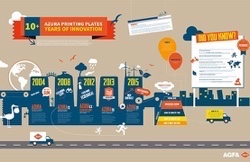Consumables
Azura: 10 Years of innovation

Friday 31. July 2015 - The first seeds for the Azura printing plates were sown as far back as the late 1960's, when one of Agfa's researchers described the use of 'latex coagulation technology' for imaging purposes for the first time. With the launch of Azura in 2004 began more than a decade of innovation and consistent improvements in printing plate developments...
10+ Years of Innovation
2004
Azura: the birth of chemistry-free printing plates
Azura is introduced at drupa 2004. It uses no water and very little gum and delivers very consistent printing results. The conventional processor is replaced by a simple and small clean-out unit. Azura is suited for commercial printing applications up to 100,000 copies. In no time, it becomes the leader in the worldwide chemistry-free market.
2008
Azura TS: longer run lengths and larger formats
The second generation of Azura increases sensitivity by about 50%, resulting in a higher throughput rate. This plate can now cover longer runs and larger formats and is no longer for the small or eco-conscious printer only. Japanese customers, known for their extremely high-quality demands, absolutely embrace the technology.
2012
Azura CX clean-out unit: spectacular gum and water savings
To support higher plate volumes, a new patented cascade clean-out technology is introduced: the CX range. An additional 60% saving in gum usage is made. Water savings compared to conventional plate processing amount to more than 95%!
2013
Azura TU: mainstream applications without compromises
Azura TU is faster than its predecessors still, thus increasing platesetter productivity. It also has a higher run length: 150,000 copies. These changes extend the plate’s application to cover the requirements of all commercial sheet-fed printers.
2015
Azura TE: Best-in-class Direct-on-Press plate
Azura TE is a Direct-on-Press plate achieving run lengths up to 75,000. It is characterized by its high image contrast, crisp quality, and fast make-ready. As it requires no processor, no chemistry, no gum and no water, needs less energy and generates no waste, it is both environment-friendly and cost-efficient.
ThermoFuseTM – Revolutionary platemaking technology
In conventional CtP systems, the heat or light from the laser hits the sensitized layers of the plate to form a latent image. Next, the plate is developed in a chemical process. This makes the latent image stable and durable.
With Agfa Graphics’ ThermoFuseTM technology, laser power is used to melt ultrafine thermoplastic particles and fuse them together to create a durable image on the aluminum plate substrate. This image does not need chemical development; it is ready immediately after imaging. The only thing left to do is to remove unused latex in the non-image areas in a clean-out step, using gum. Plates show excellent, consistent press behavior.
